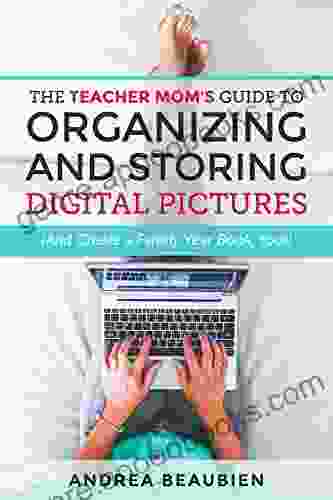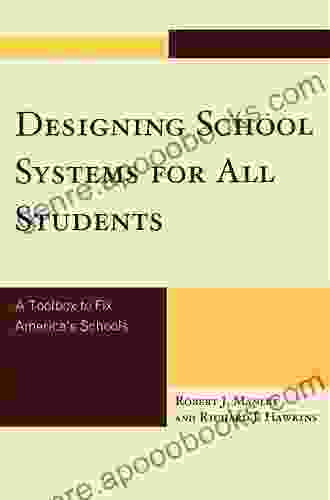Designing School Systems For All Students

A Comprehensive Guide
Every student deserves a high-quality education that prepares them for success in college, career, and life. But for too many students, the school system is not meeting their needs. Students from low-income families, students of color, and students with disabilities are disproportionately likely to attend underfunded schools with less experienced teachers and fewer resources. This results in lower academic achievement and lower graduation rates.
4.6 out of 5
| Language | : | English |
| File size | : | 1459 KB |
| Text-to-Speech | : | Enabled |
| Screen Reader | : | Supported |
| Enhanced typesetting | : | Enabled |
| Word Wise | : | Enabled |
| Print length | : | 165 pages |
We need to redesign our school systems so that they work for all students. This will require a comprehensive approach that includes changes to curriculum, instruction, assessment, and school culture. It will also require us to invest more in our schools and to ensure that all students have access to the resources they need to succeed.
This guide will provide you with the information you need to create a school system that meets the needs of all students. We will cover the following topics:
- The principles of inclusive education
- How to create a welcoming and supportive school environment
- How to design curriculum and instruction that meets the needs of all learners
- How to assess student learning fairly and accurately
- How to create a school culture that promotes equity and excellence
We hope that this guide will help you to create a school system that is truly equitable and excellent for all students.
The Principles of Inclusive Education
Inclusive education is an educational approach that seeks to include all students in general education classrooms, regardless of their background or ability. Inclusive education is based on the belief that all students can learn and that all students deserve to have access to a high-quality education.
There are a number of principles that guide inclusive education:
- All students can learn.Inclusive education is based on the belief that all students can learn and that all students deserve to have access to a high-quality education.
- Diversity is a strength.Inclusive education embraces diversity and sees it as a strength. Schools should celebrate the diversity of their students and use it to create a more vibrant and inclusive learning environment.
- Collaboration is essential.Inclusive education requires collaboration between teachers, parents, and other stakeholders. By working together, we can create a school system that meets the needs of all students.
- Flexibility is key.Inclusive education requires flexibility in curriculum, instruction, and assessment. We need to be willing to adjust our practices to meet the needs of all learners.
- High expectations are essential.Inclusive education requires high expectations for all students. We need to believe that all students can achieve success and provide them with the support they need to reach their full potential.
Inclusive education is not a one-size-fits-all approach. The best way to implement inclusive education is to tailor it to the specific needs of your school community. However, the principles of inclusive education can provide a valuable framework for creating a school system that is welcoming and supportive of all students.
Creating a Welcoming and Supportive School Environment
A welcoming and supportive school environment is essential for all students, but it is especially important for students who are from marginalized groups. When students feel safe, respected, and supported, they are more likely to succeed in school. There are a number of things that schools can do to create a more welcoming and supportive environment, including:
- Establish clear expectations for behavior. All students need to know what is expected of them in the classroom. Clear expectations help to create a safe and Free Downloadly learning environment.
- Enforce school rules fairly and consistently. All students need to know that the rules apply to everyone. Fair and consistent enforcement of school rules helps to create a sense of equity and justice.
- Respond to incidents of bullying and harassment swiftly and effectively. Bullying and harassment can have a devastating impact on students. Schools need to have a clear policy against bullying and harassment and respond to incidents quickly and effectively.
- Provide opportunities for students to get involved in school activities. Extracurricular activities can help students to develop their social skills, leadership skills, and sense of belonging.
- Celebrate diversity. Schools should celebrate the diversity of their students and use it to create a more vibrant and inclusive learning environment.
Creating a welcoming and supportive school environment is an ongoing process. It requires the commitment of all stakeholders, including teachers, administrators, parents, and students. However, the benefits of creating a welcoming and supportive school environment are clear: students are more likely to succeed in school and feel good about themselves.
Designing Curriculum and Instruction That Meets the Needs of All Learners
Curriculum and instruction are at the heart of the educational process. The curriculum is the content that students learn, and instruction is the way that content is taught. In Free Download to meet the needs of all students, curriculum and instruction must be designed to be flexible, engaging, and responsive to the individual needs of learners.
There are a number of principles that can guide the design of curriculum and instruction for all learners:
- Use a variety of teaching methods.All students learn differently, so it is important to use a variety of teaching methods to meet the needs of all learners.
- Provide multiple opportunities for students to learn.Not all students learn at the same pace or in the same way. It is important to provide multiple opportunities for students to learn the same material.
- Provide feedback that is specific, timely, and actionable.Feedback is essential for students to learn and grow. Feedback should be specific, timely, and actionable so that students can use it to improve their performance.
- Create a supportive learning environment.Students need to feel safe and supported in Free Download to learn. Create a supportive learning environment by being patient, understanding, and encouraging.
- Be flexible.Things don't always go according to plan, so be flexible and willing to adjust your curriculum and instruction as needed.
Designing curriculum and instruction that meets the needs of all learners is a challenging task, but it is an essential one. By following these principles, you can create a learning environment that is welcoming, supportive, and effective for all students.
Assessing Student Learning Fairly and Accurately
Assessment is an essential part of the educational process. It allows teachers to track student progress and identify areas where students need additional support. However, assessment can also be a source of stress and anxiety for students. It is important to design assessment practices that are fair, accurate, and supportive of student learning.
There are a number of principles that can guide the design of fair and accurate assessments:
- Use a variety of assessment methods.All students learn differently, so it is important to use a variety of assessment methods to capture student learning.
- Provide clear expectations for what students are expected to know and be able to do.Students need to know what they are being assessed on in Free Download to perform well on assessments.
- Give students multiple opportunities to demonstrate their learning.Not all students perform well on every assessment. It is important to give students multiple opportunities to demonstrate their learning.
- Use assessment to inform instruction.Assessment should be used to inform instruction, not just to grade students. Data from assessments can help teachers to identify areas where students need additional support.
- Be fair and unbiased.Assessments should be fair and unbiased so that all students have an equal opportunity to succeed.
Designing fair and accurate assessments is a challenging task, but it is an essential one. By following these principles, you can create assessment practices that are supportive of student learning and help you to make informed decisions about instruction.
Creating a School Culture That Promotes Equity and Excellence
School culture is the shared values, beliefs, and norms of a school community. A positive school culture is one that is characterized by respect, trust, and collaboration. In a positive school culture, all
4.6 out of 5
| Language | : | English |
| File size | : | 1459 KB |
| Text-to-Speech | : | Enabled |
| Screen Reader | : | Supported |
| Enhanced typesetting | : | Enabled |
| Word Wise | : | Enabled |
| Print length | : | 165 pages |
Do you want to contribute by writing guest posts on this blog?
Please contact us and send us a resume of previous articles that you have written.
 Book
Book Novel
Novel Page
Page Chapter
Chapter Text
Text Story
Story Genre
Genre Reader
Reader Library
Library Paperback
Paperback E-book
E-book Magazine
Magazine Newspaper
Newspaper Paragraph
Paragraph Sentence
Sentence Bookmark
Bookmark Shelf
Shelf Glossary
Glossary Bibliography
Bibliography Foreword
Foreword Preface
Preface Synopsis
Synopsis Annotation
Annotation Footnote
Footnote Manuscript
Manuscript Scroll
Scroll Codex
Codex Tome
Tome Bestseller
Bestseller Classics
Classics Library card
Library card Narrative
Narrative Biography
Biography Autobiography
Autobiography Memoir
Memoir Reference
Reference Encyclopedia
Encyclopedia Miroslav Kucera
Miroslav Kucera Wendy Webb
Wendy Webb Yucca Harris
Yucca Harris Susan Anderson
Susan Anderson Walter Holland
Walter Holland Laura Moriarty
Laura Moriarty Thijs Pepping
Thijs Pepping Steven Ross
Steven Ross Randi Alexander
Randi Alexander Yehuda Pinchover
Yehuda Pinchover William J Lipham
William J Lipham Sylvain Laforest
Sylvain Laforest Kim Newman
Kim Newman Lea M Mcgee
Lea M Mcgee Susan Wise Bauer
Susan Wise Bauer Kimberly Kay Hoang
Kimberly Kay Hoang Travis Breeding
Travis Breeding Miranda Kulig
Miranda Kulig Michael Shellenberger
Michael Shellenberger Regina Schaffer
Regina Schaffer
Light bulbAdvertise smarter! Our strategic ad space ensures maximum exposure. Reserve your spot today!

 Amir SimmonsCreate a Family Year Too: A Revolutionary Guide to Plan Your Best Year Ever,...
Amir SimmonsCreate a Family Year Too: A Revolutionary Guide to Plan Your Best Year Ever,...
 Miguel de CervantesOcculted Songwriting Tips And Secrets Revealed: Unlock Your Musical Genius
Miguel de CervantesOcculted Songwriting Tips And Secrets Revealed: Unlock Your Musical Genius Liam WardFollow ·9.5k
Liam WardFollow ·9.5k Harry HayesFollow ·8.3k
Harry HayesFollow ·8.3k Dennis HayesFollow ·3.3k
Dennis HayesFollow ·3.3k Junot DíazFollow ·11.5k
Junot DíazFollow ·11.5k Alec HayesFollow ·19.5k
Alec HayesFollow ·19.5k Dakota PowellFollow ·8.5k
Dakota PowellFollow ·8.5k Rick NelsonFollow ·15.8k
Rick NelsonFollow ·15.8k Jett PowellFollow ·7.8k
Jett PowellFollow ·7.8k

 Finn Cox
Finn CoxCarmen Suite For Flute Quartet (G Alto Flute) ( Carmen...
Experience the Magic of...

 Andy Cole
Andy ColeUncover Hidden Truths: A Comprehensive Guide to Detecting...
: The Silent...

 Ken Simmons
Ken SimmonsUnleash Your Potential: Transform Frustration and...
Are you tired of feeling...

 Rick Nelson
Rick NelsonHard To Kill: A Gripping Thriller That Will Keep You on...
Tom Rollins is a...

 Ivan Turner
Ivan TurnerUnleash the Power of Your Breath: Discover Breath...
In the tapestry of life, where stress and...
4.6 out of 5
| Language | : | English |
| File size | : | 1459 KB |
| Text-to-Speech | : | Enabled |
| Screen Reader | : | Supported |
| Enhanced typesetting | : | Enabled |
| Word Wise | : | Enabled |
| Print length | : | 165 pages |










